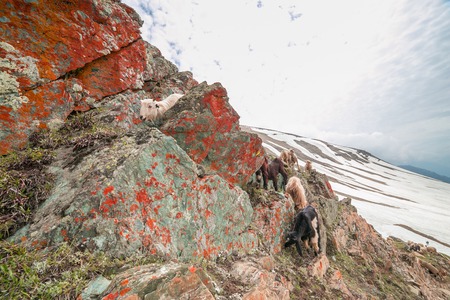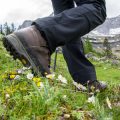Understanding Enclosed Pastures in the British Countryside
Step into the gentle embrace of the British countryside, and you’ll find yourself wandering through a mosaic of fields and hedgerows, where time seems to flow as softly as the breeze. Enclosed pastures—those green parcels of land bordered by ancient drystone walls, timber fencing, or tangled hawthorn hedges—are more than just a visual hallmark; they are living chapters in the story of rural Britain. These pastures speak of centuries-old farming practices, shaped by generations who tended livestock with care and respect for the land. As you set out on footpaths weaving through this pastoral patchwork, it becomes clear that each enclosure is more than a boundary; it is a carefully managed space, often home to sheep or cattle. For walkers, these enclosed landscapes create a unique environment—one that is both inviting and alive with the daily rhythms of farm life. Understanding their significance is essential: not only do they offer glimpses into traditional agricultural methods, but they also present distinct considerations for anyone wishing to navigate safely and thoughtfully among grazing animals.
2. Recognising Different Types of Livestock
Strolling through the patchwork fields of the British countryside, you’ll often find yourself sharing space with a host of grazing animals. Knowing how to identify different types of livestock is key to navigating enclosed pastures safely and respectfully. Each species has its own temperament, habits, and subtle cues that can help you judge the safest path forward.
Common British Livestock at a Glance
| Livestock | Physical Features | Behavioural Traits | Safety Considerations |
|---|---|---|---|
| Cattle (Cows, Bulls) | Large build, short fur, horns (varied), broad face | Curious, may approach walkers; bulls and cows with calves can be protective | Avoid eye contact and direct paths through herds; give wide berth to mothers with young or any lone bull |
| Sheep | Woolly coats, smaller stature, gentle faces, often in flocks | Nervous, usually flee from humans; lambing season brings protective ewes | Move quietly and avoid splitting flocks; keep dogs on leads during lambing |
| Horses & Ponies | Sleek bodies, flowing manes/tails, expressive eyes | Curious but skittish; may gallop unexpectedly in groups | Stay calm and steady-paced; do not feed or approach directly from behind |
| Pigs (Outdoor Rare Breed) | Stout build, bristly hair, upturned snouts, small groups | Sociable but unpredictable when startled; keen sense of smell | Avoid sudden movements; walk around groups rather than through them |
The Subtle Signs: Reading the Pasture’s Mood
The countryside whispers its stories through the smallest gestures: a flick of an ear, a sideways glance from under heavy lashes. If you notice cattle bunching together or staring intently, this may signal agitation—perhaps they feel threatened by your presence. Sheep scattering ahead is usually nothing more than skittishness, while horses swishing their tails or pawing the earth could mean impatience or anxiety. Quiet observation is your ally; take a moment to pause and read these signals before proceeding.

3. Reading the Landscape: Identifying Paths and Public Rights of Way
Stepping into a field where cattle graze or sheep wander, one quickly learns that the British countryside is a patchwork of ancient routes and modern boundaries. Navigating enclosed pastures safely starts with recognising the public rights of way woven across these green spaces. In the UK, public footpaths are more than just worn tracks; they are threads connecting villages, woods, and wildflower meadows, each marked for those willing to look closely.
Spotting Footpaths: Subtle Signs in Nature
The first tip is to keep an eye out for well-trodden paths running alongside hedgerows or skirting fields. These often indicate established rights of way. However, in spring and summer, long grass can obscure these trails. Instead, look for subtle clues such as regularly flattened vegetation or a line of slightly worn earth tracing its way through pasture.
Stiles and Kissing Gates: Gateways to Tradition
In many pastures, your route will be punctuated by traditional stiles—wooden or stone steps that help walkers cross fences or drystone walls without disturbing livestock. Equally common are kissing gates, their charming name recalling a gentle swing through which only one person may pass at a time, ensuring animals remain securely enclosed. Both stiles and kissing gates are reassuring signs you’re on a sanctioned path.
Waymarkers: The Walker’s Silent Guide
Public rights of way in Britain are frequently marked by discreet but clear waymarkers. Look for small discs or arrows fixed to posts, trees, or gates—often yellow for footpaths and blue for bridleways. These markers guide you through even the most confusing patchworks of pasture and field boundaries, helping you avoid wandering onto private land or into areas where livestock might feel threatened by your presence.
By learning to read these signs in the landscape, you not only ensure your own safety but also uphold the quiet respect that underpins every ramble across Britain’s fields—honouring both tradition and nature’s enduring story.
4. Safety Around Livestock: Local Practices and Etiquette
Wandering through the patchwork fields of the British countryside, it’s not uncommon to find yourself sharing space with grazing sheep or inquisitive cattle. Here, tradition and practicality entwine; knowing how to behave around livestock is as much about respecting rural customs as it is about ensuring your own safety. While the landscape may seem timeless, the etiquette for traversing these spaces is shaped by generations of coexistence between walkers and farmers.
Understanding Signage and Farmer Communication
When entering a pasture, pay close attention to signage. Signs such as “Please close the gate,” “Beware of bull,” or “Cattle in field” are common throughout Britain’s rural pathways. These signs are more than mere instructions—they are invitations to participate respectfully in a shared way of life. If you encounter a farmer, a friendly wave or brief greeting is customary; if you’re uncertain about a route, asking for guidance is welcomed and often met with local stories or helpful advice.
The Unwritten Rules: Walking with Care
Beyond formal notices, there are unwritten rules that every walker is expected to know. These customs have evolved from years of experience and quiet understanding between those who farm the land and those who traverse it. The table below outlines some key practices:
Situation |
Expected Behaviour |
|---|---|
| If animals approach you | Stay calm, keep moving steadily, and avoid direct eye contact; do not run. |
| Walking with dogs | Keep dogs on a short lead, especially near livestock; let go if threatened by cattle so the dog can escape. |
| Encountering gates or stiles | Always leave gates as you found them—open or closed—to maintain livestock boundaries. |
| If animals block your path | Give them space and take a wide berth; never corner or surprise them. |
| If you see farm machinery working nearby | Wait until its safe to pass, making sure youve been seen by the operator. |
Cultural Sensitivity: Respecting Rural Ways
The British countryside is cherished for its tranquillity and sense of continuity. By observing these small acts of consideration—acknowledging landowners, taking care with animals, and following posted guidance—you help preserve this delicate balance. Ultimately, traversing enclosed pastures is not just about finding a safe route; it’s about joining a story that has unfolded over centuries, where each respectful step keeps the dialogue between visitor and land alive.
5. Adapting to Changing Conditions
The British countryside is ever-changing, shaped by the rhythm of the seasons and the whims of the weather. As you traverse enclosed pastures, it’s essential to remain mindful of how these elements can influence both the landscape and livestock behaviour. A sudden downpour may transform a firm footpath into a muddy quagmire, making navigation more challenging and potentially obscuring waymarkers. In spring and early summer, fields may be lush with new growth, but this abundance can conceal uneven ground or hidden obstacles. Conversely, winter’s bare expanses offer clearer sightlines but may bring frozen gates or slippery surfaces.
Livestock movements are equally dynamic. Flocks and herds are often rotated between fields throughout the year; sheep may be docile in one season but protective during lambing, while cattle might cluster near gates for shelter during inclement weather. Always observe animals from a distance before entering a pasture, noting their position and behaviour. If a path seems crowded or blocked by livestock, it’s wise to wait patiently for them to move on or choose an alternative route if available.
Farmers sometimes reroute footpaths temporarily due to field management—haymaking, silaging, or calving—and these diversions are usually signposted. Take extra care to follow these notices; they’re there to keep both walkers and animals safe. When in doubt, consult the latest Ordnance Survey maps or local council updates online before setting out.
Above all, adaptability is your greatest companion. Carry sturdy boots for muddy stretches and waterproofs for sudden showers—a typical British necessity. Be prepared for the unexpected: a friendly farmer redirecting you around a working dog, or a flock of geese taking up residence near a stile. Embracing these changes with respect and good humour not only keeps your journey safe but also connects you more deeply to the living tapestry of rural Britain.
6. What to Do in Case of Unexpected Encounters
Even the most seasoned walker can find themselves suddenly facing a curious herd or an inquisitive cow blocking the stile. In these moments, it’s essential to stay grounded in practical countryside wisdom and keep your wits about you. Here’s how you can navigate such encounters with calm and confidence, ensuring both your safety and the welfare of the animals.
Pause and Take Stock
If livestock approach or seem unsettled by your presence, stop and assess the situation. Animals often react to sudden movements, so take a moment to observe their behaviour. Are they simply curious, or do they appear agitated? A calm stance can help diffuse tension and give you time to plan your next steps.
Keep Calm and Carry On—Gently
Avoid shouting or making abrupt gestures, as this can startle animals. Speak softly if needed, reassuring both yourself and any companions. If you have a dog with you, keep it on a short lead and under close control; if cattle become overly interested in your dog, be prepared to let go of the lead for everyone’s safety.
Plot a Sensible Retreat
If a safe path ahead is blocked, consider retracing your steps or skirting around at a respectful distance—always keeping to the edge of the field where possible. Don’t turn your back entirely; instead, walk steadily while keeping an eye on the livestock. Never run, as this may provoke chasing instincts.
Use Natural Barriers Wisely
If there are trees, bushes, or even fence lines nearby, these can provide a natural buffer between you and inquisitive animals. Move calmly towards these features without appearing panicked. Avoid squeezing through gaps that could leave you cornered or unable to retreat safely.
Seek Help if Needed
If you feel truly threatened or unable to proceed safely, don’t hesitate to call for assistance—whether that’s alerting a nearby farmer or phoning emergency services if circumstances warrant it. Your wellbeing is always paramount.
Remember: most livestock are more interested in grazing than causing trouble. By staying composed and respectful of their space, you’re honouring generations-old countryside etiquette—and ensuring that every ramble remains a story worth retelling beneath wide British skies.


